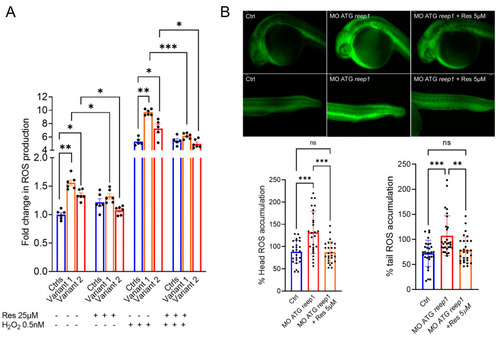Figure 6
- ID
- ZDB-FIG-230228-404
- Publication
- Naef et al., 2023 - Converging Role for REEP1/SPG31 in Oxidative Stress
- Other Figures
- All Figure Page
- Back to All Figure Page
|
Evaluation of the susceptibility to oxidative stress in REEP1/SPG31 disease models and resveratrol modulatory effect on ROS overproduction. (A) Under both regular medium (RM) and stress conditions, patients produced a significantly greater amount of ROS compared with controls, indicating an increased susceptibility to oxidative stress. Resveratrol treatment reduces the ROS levels restoring the control values. Data represent mean ± SEM of controls (n = 3) and patients (n = 2 for each mutation) analyzed in technical duplicate (controls) or triplicate (patients). Statistical analysis was performed by ordinary ANOVA test (one-way ANOVA). * p < 0.05; ** p < 0.01; *** p < 0.001. (B) Representative fluorescence images of ROS generation in zebrafish larvae at 24 hpf (MO ATG reep1 n = 30; controls n = 30; MO ATG reep1+ Res 5µM n = 30, in 3 independent experiments. Graphs show the quantitative analysis of fluorescent signals. *** p < 0.01 was calculated by Dunnett’s multiple comparisons test. Abbreviations: n, number of evaluated embryos in total; ns, not significant. The values are expressed as mean ± standard deviation (SD). |
| Fish: | |
|---|---|
| Condition: | |
| Knockdown Reagent: | |
| Observed In: | |
| Stage: | Prim-5 |

